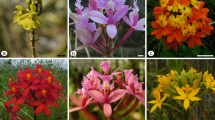Abstract
The reproductive system ofProsopis chilensis, P. pugionata, P. flexuosa, andP. torquata is described. Observations were made of floral morphology, stigmatic receptivity, pollen grain viability, and the nature of pollen reserves. Scanning electrone microscopy and statistical analysis were carried out. The results allow us to conclude that: 1) The studied species have three distinct floral morphs characterized by significantly different style lengths and, to a lesser extent, different stamen lengths; 2) style precocity found in all species does not indicate protogyny; 3) flowers with shortest styles are not receptive; 4) the pollen grains of all floral morphs showed high viability; 5) peroxidase is present in both the pollen and pistil; 6) viable pollen grains invariably have both starch and pollenkitt; 7) the studied species are andromonoecious.
Similar content being viewed by others
References
Baker, H. G., Baker, I., 1979: Starch in angiosperm pollen grains and its evolutionary significance. — Amer. J. Bot.66: 591–600.
Burkart, A., 1937: Estudios morfológicos y etológicos en el géneroProsopis. — Darwiniana3: 27–47.
Carraro, L., Lombardo, G., Gerola, F. M., 1986: Stylar peroxidase and incompatibility reactions inPetunia hybrida. — J. Cell. Sci.82: 1–10.
De Souza, S., Felker, P., 1986: The influence of stock plant fertilization on tissue concentrations of N, P, and carbohydrates and the rooting ofProsopis alba cuttings. — Forest Ecol. Manag.16: 181–190.
Dixon, W. J., (Ed.), 1981: BMDP statistical software. — Berkeley: University of California Press.
Dnyansagar, V. R., 1957: Embryological studies in theLeguminosae. V.Prosopis spicigera andDesmanthus virgatus. — Bot. Gaz.118: 180–186.
F.A.O., 1980: Genetic resources of tree species in arid and semiarid areas: a survey for the improvement of rural living in Latin America, Africa, India, and South-West Asia. — Rome.
Genise, J., Palacios, R. A., Hoc, P. S., Carrizo, R., Moffat, L., Mom, M. P., Agullo, M. A., Picca, P., Torregrosa, S., 1990: Observaciones sobre la biología floral deProsopis (Leguminosae, Mimosoideae). II. Fases florales y visitantes en el distrito chaqueño serrano. — Darwiniana30: 71–85.
—, 1991: Some new aspects of the floral biology ofProsopis (Leguminosae, Mimosoideae): behaviour of the main insect visitors in West-Chaco (Argentina). — Bull. Int. Group StudyMimosoideae 19: 130–145.
Greissl, R., 1989: Vitality analysis of monadic and polyadic pollen grains using optical contrast-fluorescence microscopy. — Sci. Tech. Inform.15: 180–184.
Heslop-Harrison, Y., 1981: Stigma characteristics and angiosperm taxonomy. — Nordic J. Bot.1: 401–420.
—, 1977: The receptive surface of the angiosperm stigma. — Ann. Bot.41: 1233–1258.
Hoffman, A., 1970: Desarrollo del microsporangio, saco embrional y anatomía de la testa del algarrobo. — Turrialba20: 9–14.
Jensen, W., 1962: Botanical histochemistry. Principles and practice. — San Francisco: Freeman.
Johansen, D. A., 1940: Plant microtechnique. — New York: McGraw Hill.
National Academy Of Sciences, 1979: Tropical legumes: resources for the future. — Washington, D.C.
- 1980: Firewood crops. Shrub and tree species for energy production. — Washington, D.C.
Nettancourt, D. De, 1977: Incompatibility systems in angiosperms. — Berlin, Heidelberg, New York: Springer.
Osborn, N. M., Kevan, P. G., Lane, M., 1988: Pollination biology ofOpuntia polyacantha andOpuntia phaeacantha (Cactaceae) in southern Colorado. — Pl. Syst. Evol.159: 85–94.
Richards, A. J., 1986: Plant breeding systems. — London: Allen & Unwin.
Simpson, B. B., Neff, J. L., Moldenke, A. R., 1977:Prosopis flowers as a resource. — InSimpson, B. B., (Ed.): Mesquite: Its biology in two desert ecosystems. — U.S./I.B.P. synthesis series5: 84–107. — Stroudsburg: Dowden, Hutchinson and Ross.
Solbrig, O. T., Cantino, P. D., 1975: Reproductive adaptations inProsopis (Leguminosae, Mimosoideae). — J. Arnold Arbor.56: 185–210.
Author information
Authors and Affiliations
Rights and permissions
About this article
Cite this article
Hoc, P.S., Agulló, M.A. & Palacios, R.A. Stylar trimorphism in four functionally andromonoeciousProsopis species (Mimosaceae). Pl Syst Evol 190, 143–156 (1994). https://doi.org/10.1007/BF00986190
Received:
Revised:
Accepted:
Issue Date:
DOI: https://doi.org/10.1007/BF00986190




